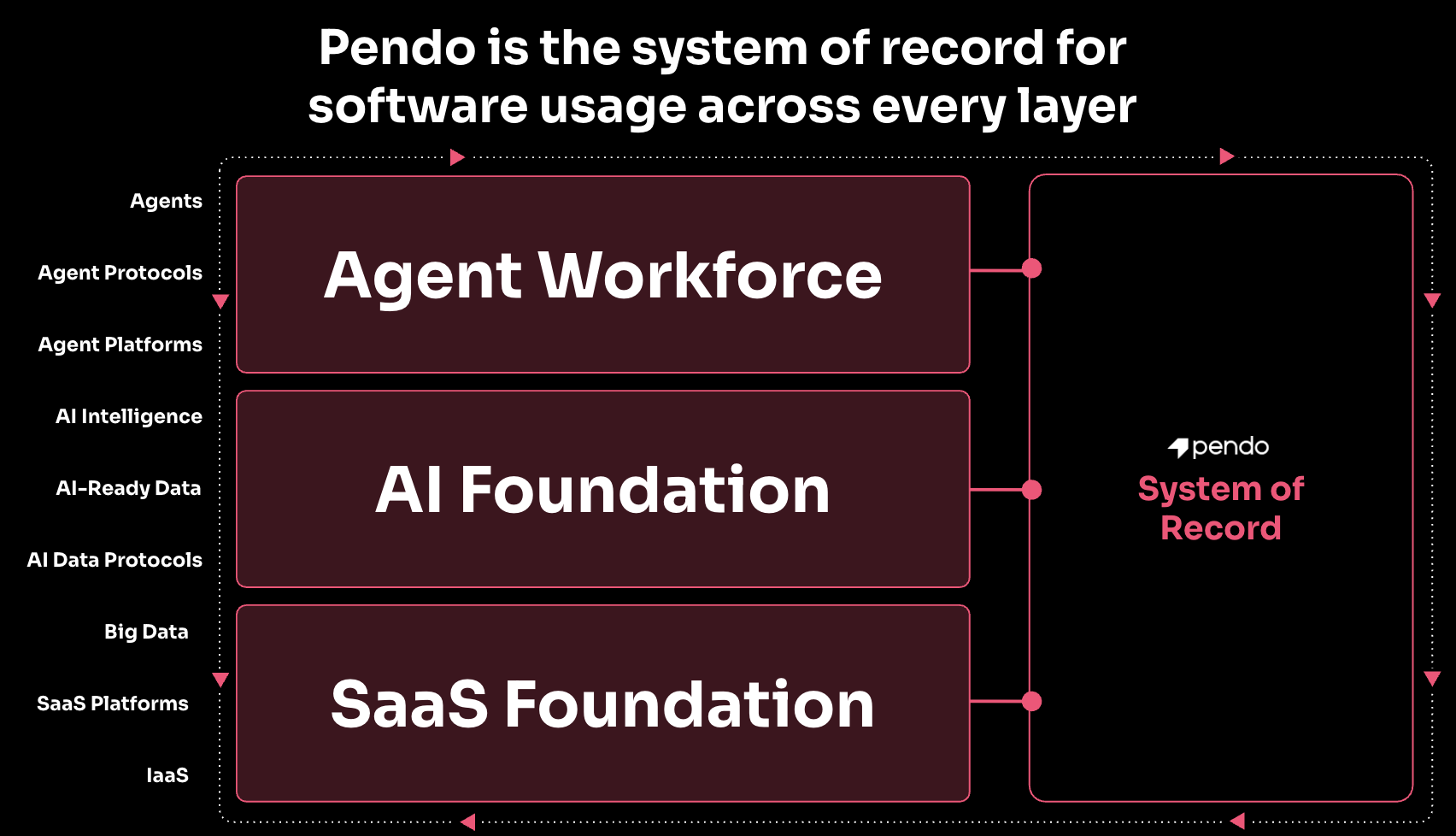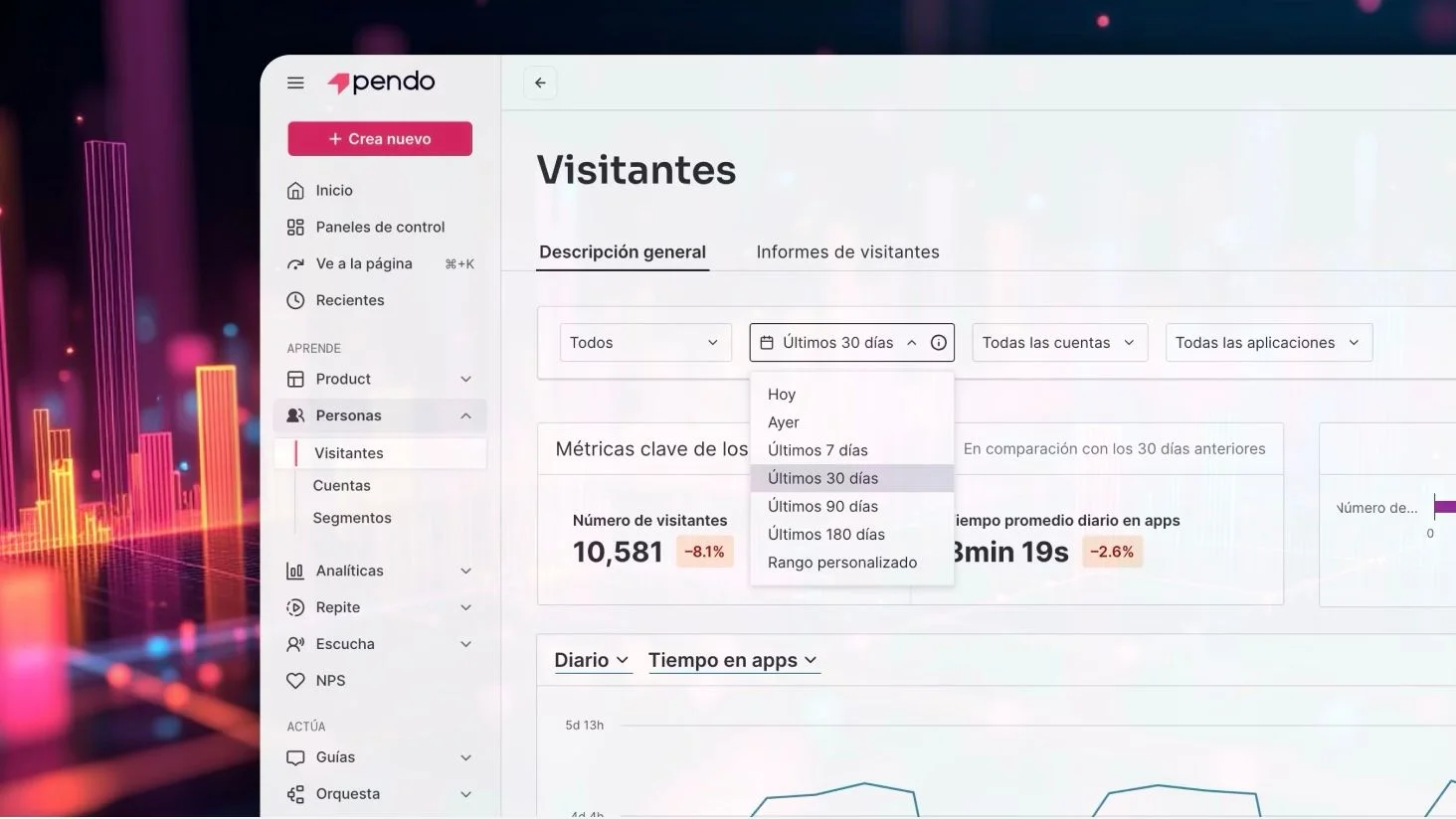What a day. We covered a lot of ground during PendomoniumX NYC—from navigating the AI revolution, to mastering the product operating model, to the latest Pendo innovations.
In case you missed any of the details (or were unable to join us live in the Big Apple), here’s a recap of the day’s biggest highlights, tech takeaways, and stories.
SaaS isn’t dead—in fact, it’s more important than ever | Todd Olson, Pendo CEO and Co-founder
Pendo CEO and Co-founder Todd Olson opened PendomoniumX NYC with a keynote exploring how organizations must evolve to thrive in AI era. With a seemingly new AI innovation daily, companies can no longer simply “retire the jersey” on digital transformation. Instead, they must straddle all this technology, maintaining on-premise systems, SaaS applications, and now adding AI and agent capabilities.
We’ve moved through distinct eras of digital transformation, from on-premise solutions to the SaaS era and now into the SaaS + AI Agent Era.
Every company needs to become an intelligent software company, knowing that digital workers will soon augment and even replace human labor. This isn’t doom and gloom—it’s the industry reality that presents tremendous opportunities for those who adapt.
Success in the agentic era depends on three interconnected foundational layers:
- The SaaS foundation: Cloud software platforms—think Salesforce, ServiceNow, and Zendesk—underpin core business processes. Enterprises blend SaaS data in data warehouses/lakes and via integrations in order to get the fullest picture of company performance and drive decision-making.
- AI foundation: AI services that interpret, predict, and optimize based on data from your SaaS foundation to create AI-ready data. Without structured, actionable data optimized for AI training and operational insights, you risk falling behind competitors.
- Agent workforce: Your digital workers who pursue goals and complete tasks on behalf of users. Agents show reasoning, planning, and memory and have the autonomy to make decisions, learn, and adapt.
At Pendo, we want to build that system of record, ensuring you have the most effective use of data across every layer. Our goal is to help companies understand how both human users and AI agents interact with software so they can optimize their tech stack for business impact.
AI-ready SaaS with 16+ new features in Pendo | Brian Walsh, Pendo SVP of Product
Next, Brian Walsh outlined Pendo’s vision for this new era and introduced 16 new product capabilities designed to help organizations navigate the transition.
These features focus on three critical use cases: building smarter onboarding experiences, accelerating user success, and driving growth through better product experiences. From Pendo Web Analytics to embedded guides and A/B testing capabilities, Walsh demonstrated how Pendo is evolving to support product teams in this new “SaaS + AI era” while ensuring they deliver maximum value from their technology investments.
Some of Pendo’s newest features include:
- Pendo Agent Analytics is a first-of-its-kind solution that helps you understand and improve AI agent performance, whether you’re building or deploying them. This gives leaders the ability to understand user intent, connect agent activity to business outcomes, and mitigate compliance risk.
- A feedback agent is now live in Pendo Listen for all customers; it automatically triages feedback and responds to your questions in natural language. This digital worker is the first step toward our Product Operations (ProdOps) Manager Agent.
- Guide Experiments to help you A/B test and optimize the impact of your in-app communications.
- Pendo Web Analytics for full-funnel visibility into what users do before, during, and after engaging with your software. With Web Analytics, you can connect web traffic to in-app behavior to understand which channels and campaigns drive adoption.
This is just a peek into what Walsh unveiled at PNDMx NYC. See everything that’s new.
Common antipatterns to avoid during your move to the product operating model | Lea Hickman, SVPG
Lea Hickman, partner at SVPG and co-author of TRANSFORMED: Moving to the Product Operating Model, spoke on how to transition from output– to outcome-driven product development via the Product Operating Model.
Hickman outlined three fundamental steps organizations must take to adopt this model:
- Choosing which problems to solve requires the right mindset and culture
- Changing how you solve problems and, evolving beyond traditional, expected approaches
- Changing how you build with a laser focus on outcomes over output.
Of course, it’s not as simple as that. Hickman has seen this transformation fail many times, and “the biggest mistake” companies make is underestimating the CEO’s role during digital transformation. You can’t just hire a digital transformation leader and forget to let them run with it—the CEO needs to be continuously involved, championing change firsthand.
Another mistake companies often make is skipping analysis and iteration. Digital products give you real-time behavioral data, but many teams ignore analyzing and acting on this data. At Adobe, Hickman implemented a rule that “no feature would be released unless it was measured by telemetry and behavioral data to enable evidence-based decisions.” This created a culture of data-driven decision-making and encouraged the product team to stay close to real outcomes instead of shipping features.
By fighting against these antipatterns, prioritizing innovation over predictability, and setting clear, company-wide priorities, product teams can rapidly test, iterate with customers, and ruthlessly prioritize their resources.
Sending a huge thank-you to our sponsors Lucid, ProductBoard, Mind the Product, Google, and Merge for helping make this incredible event possible. To learn more, explore the Summer ‘25 Release or talk to an expert.

![[object Object]](https://cdn.builder.io/api/v1/image/assets%2F6a96e08774184353b3aa88032e406411%2F8ce5433e44c14f90a1f0893e17761812?format=webp)
![[object Object]](https://cdn.builder.io/api/v1/image/assets%2F6a96e08774184353b3aa88032e406411%2F8472924f687a4c359fb61b69d3ac4ea4?format=webp)


